
Keeping up with digital commerce buzzwords may seem like a full-time job these days. Let’s unpack the difference between the main terms — so you can keep calm and carry on with your digital transformation.
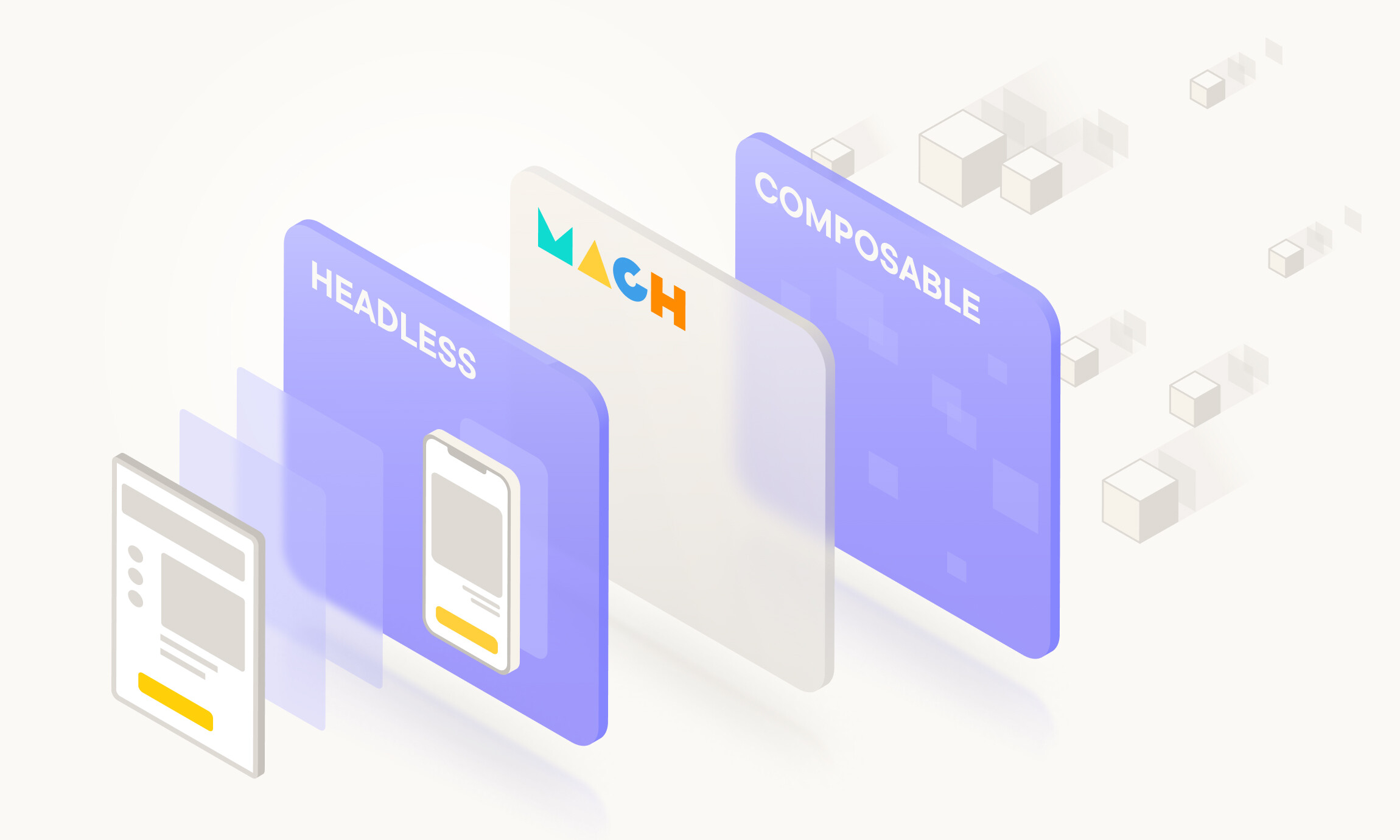
Monolithic architecture vs. headless commerce
Monolithic platforms and headless commerce are distinct approaches to building and managing eCommerce solutions.
Monolithic platforms, also known as legacy platforms or all-in-one suites, are integrated systems with tightly coupled components, offering a pre-packaged software stack. The name “monolith” refers to ancient monolithic structures such as temples or buildings carved from a single massive stone and has become the reference for "monolithic" software architecture built as a single atomic unit.
In digital commerce, a monolithic platform usually provides standardized eCommerce components that are tightly coupled. These legacy platforms dominated the desktop-only eCommerce landscape by providing all classic commerce features in one place. Because all functionalities are tied together with a single codebase, performing changes or customizations is hard to achieve. As a result, companies accumulate technical debt rapidly and innovation falls flat.
Headless commerce, coined by commercetools CEO and co-founder, Dirk Hoerig, arose in the early 2010s as the answer to the shortcomings of monolithic platforms. In short, a headless commerce platform decouples the frontends (the customer-facing layer, like your webshop or Instagram profile) and backend (the commerce engine handling all product, pricing and customer data). By operating independently, the frontends and backends can be changed, updated and customized without affecting one another or the overall infrastructure, reducing downtime or potential crashes.
With a microservice-based approach, headless architecture consists of components that are loosely coupled modules with distinct functions, each with its own repository, logic and deployment process. With smaller-scale pieces seamlessly connected, companies can become more agile and adapt faster to market forces.
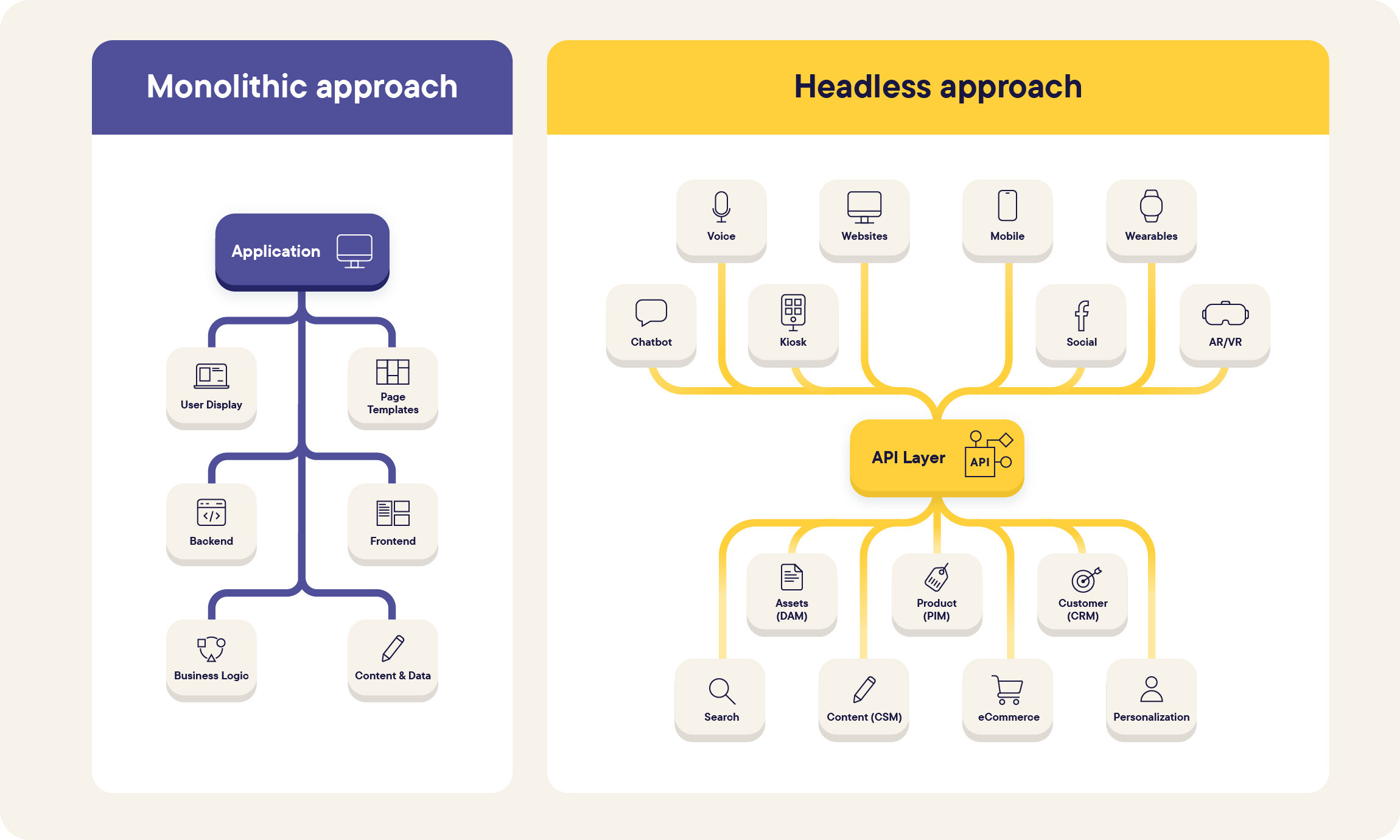
Here’s an overview of how they compare:
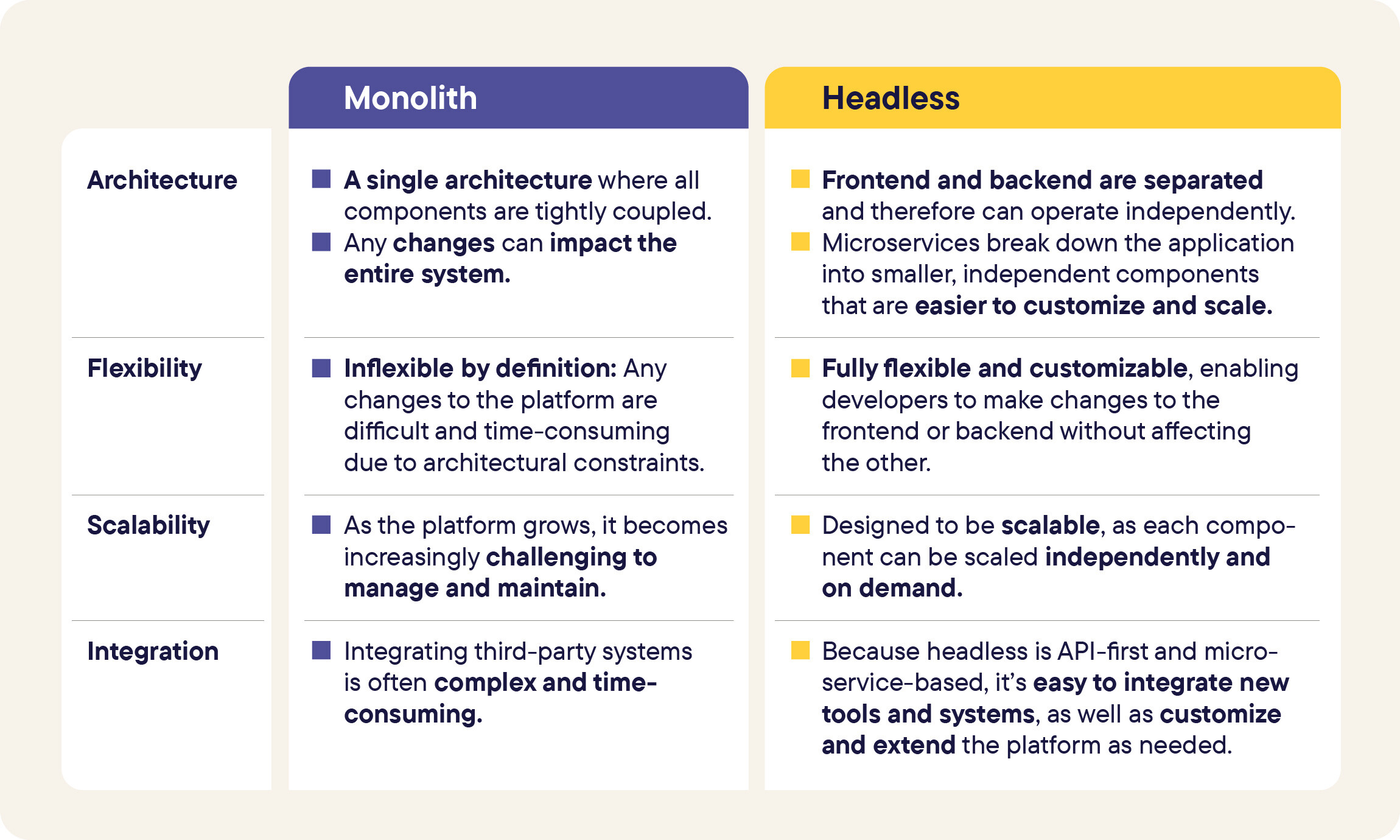
Monolithic applications may benefit companies lacking developer resources and/or when customization is unnecessary. However, it’s common that companies quickly outgrow monolithic platforms and adopt headless commerce solutions to accommodate growth potential. As a further step forward, companies are modernizing their architecture with composable commerce.
Composable commerce vs. headless
The main difference between headless and composable commerce is in the structure and approach to building eCommerce experiences. Headless technology decouples the frontend presentation layer from the backend commerce functionality, allowing for more flexibility and customization in how the user interface is created and managed.
On the other hand, a composable commerce solution takes a step beyond headless by breaking down the entire commerce stack into modular components that can be assembled and reassembled like building blocks, enabling all the benefits of headless technology but with even greater agility, stability and scalability in creating tailored eCommerce solutions.
Initially, a headless tech stack was the first step for breaking down the monolith, but despite this progress, legacy commerce platforms can still be headless but with a monolithic (non-microservices-based) architecture behind the scenes. This means companies may still find it difficult to unlock all the benefits of modern commerce.
That’s where composable commerce technology comes in. It enables businesses to “compose” unique customer experiences by plugging best-of-breed building blocks like cart, checkout and payments into their technology stack. Composable commerce architecture leans on being component-based, tech-agnostic, and cloud-native.
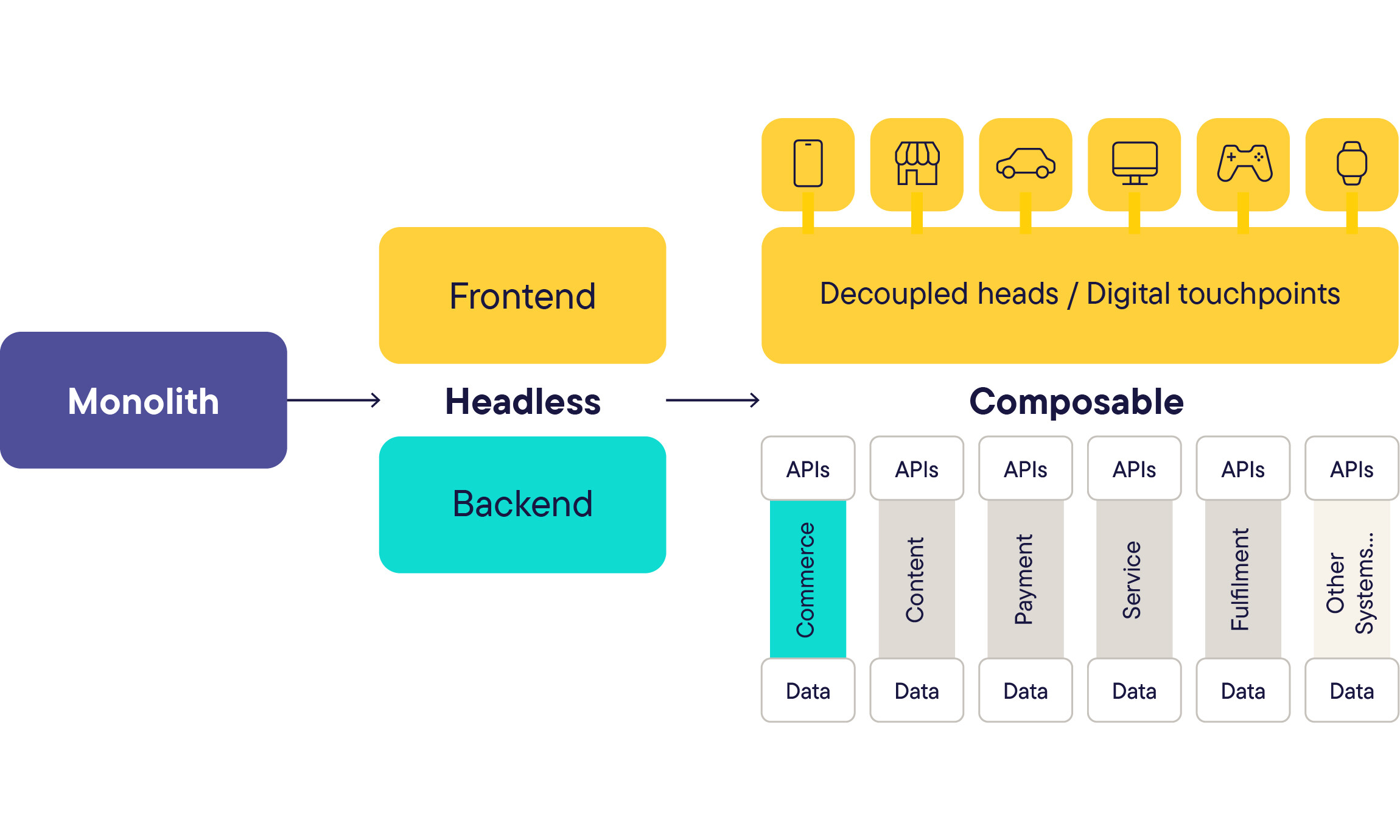
All-in-one vs. best-of-breed
As the name suggests, "all-in-one commerce" platforms offer a comprehensive suite of features, providing all classic commerce features in one place. You can compare it to a Swiss army knife with the basic features of eCommerce, such as content management, payment processing, shipping, personalization, marketing, inventory management, invoicing and so on.
While a fixed package from a single vendor may reduce time-to-market — especially when developer resources are scarce — you’re essentially paying for a bunch of features regardless of whether they're beneficial to your business. Other problems with the all-in-one approach include hard-to-customize functions and integrating with third-party systems. As a result, creating unique customer experiences becomes a tall order for companies that need to stand out from the crowd.
A best-of-breed approach solves these issues by allowing you to choose the ideal tools for your digital commerce experience. Instead of a pre-packaged solution, you can plug in the components that best suit your business needs. It means you don’t have to sacrifice functionality according to a vendor’s limitations. In short, instead of using a Swiss army knife for everything (imagine dicing vegetables or cutting cloth with one toolset), you get specialized tools for your unique use cases without vendor lock-in. After all, it’s unlikely that an all-in-one platform can provide a top-notch service encompassing all of the components needed to build a digital commerce platform, such as a CMS, payment, search, etc.
In order to truly tailor the customer experience and foster technology efficiency in an ever-evolving marketplace, a best-of-breed approach provides a more suitable solution for businesses to stay ahead of the competition, customer demands and market fluctuations. That's why best-of-breed is one of the tenets of composable commerce.
Microservices vs. Packaged Business Capabilities (PBCs)
While monolithic platforms are built on a single codebase, microservices-based architectures split an application into smaller, independent, loosely coupled components. Each of these microservices undertakes a specific and granular process without depending on other services. On the other hand, packaged business capabilities (PBCs) are applications or services developed around a particular business function, usually grouping multiple microservices to address a specific business capability.
According to Gartner, PBCs are “Independently deployable capabilities that include self-contained business data, logic and processes to perform a business function. These interact with other applications via APIs and event channels.” These capabilities or components (product information, product discovery or payments) are from potentially different vendors, with each vendor exclusively owning its data.
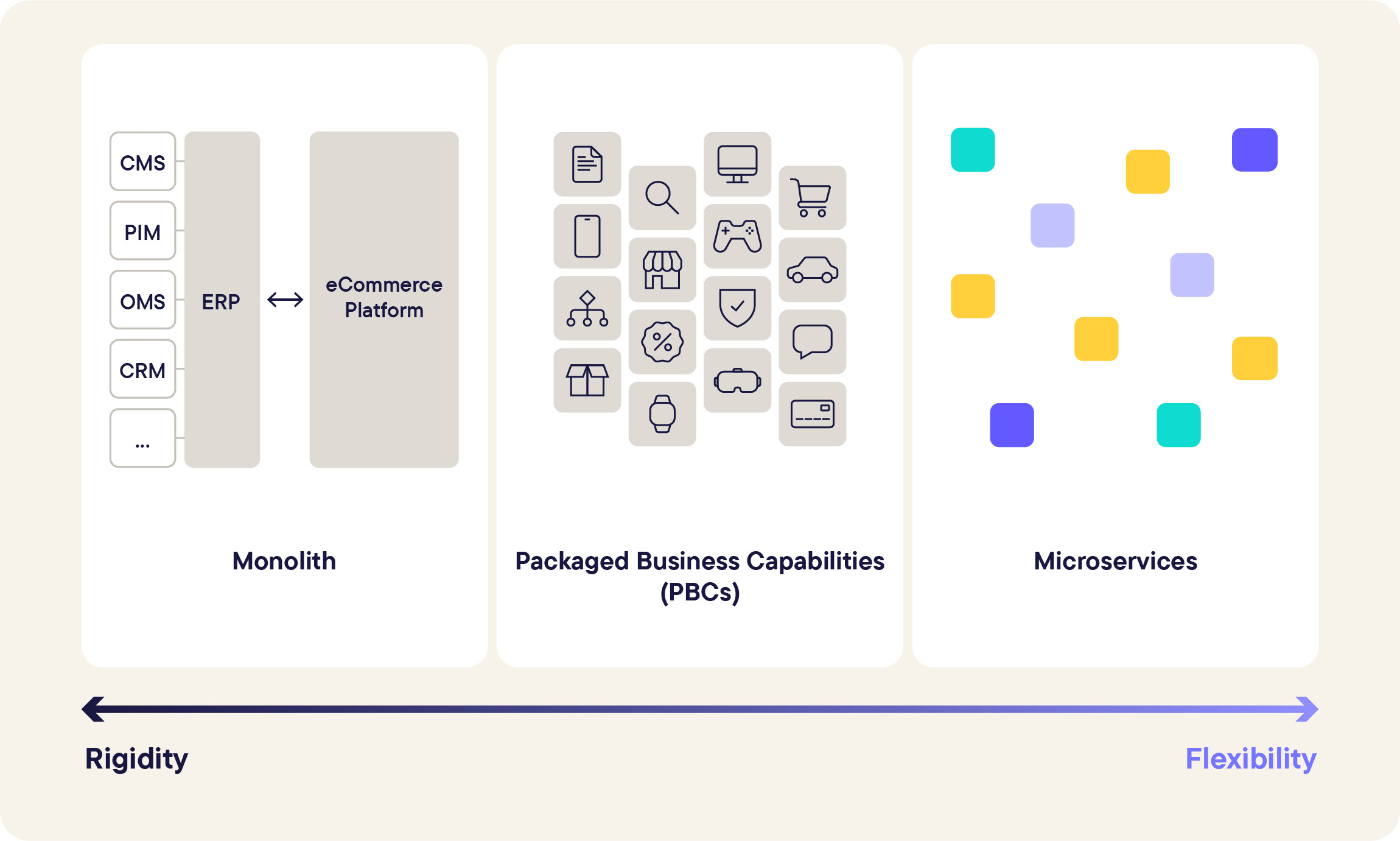
For example, product variants, attributes and categories are independent but loosely coupled microservices that deliver business functionality and communicate via APIs. Together, they form a PBC or component commonly known as Product Catalog.
In a nutshell, PBCs are an efficient way to organize your microservices based on your business needs, simplifying operations without jeopardizing flexibility.
Composable commerce vs. MACH architecture
Composable commerce is often used interchangeably with MACH architecture, but these concepts aren’t the same thing.
The main difference between MACH and composable commerce is that a composable tech stack comprises many distinct services such as search, product discovery and checkout to power up user experiences. On the other hand, MACH is the combination of multiple technologies providing a genuinely open, modular environment for businesses to boost innovation and respond to change quickly.
MACH can be considered the enabler of composable commerce because:
With a microservices architecture, the entire eCommerce solution is broken down into smaller services that can be managed and scaled autonomously, enabling businesses to choose the best-in-class services for each function.
The API-first approach ensures that each component can communicate with one another, even if they are built by different vendors.
The cloud-native aspect allows businesses to build and deploy the entire eCommerce solution on a cloud-based platform, which provides greater scalability, security and reliability. Also, it enables companies to move away from traditional on-premises infrastructure, reducing the cost of maintaining servers in-house.
Decoupling frontends and backends powered by headless commerce architecture is the first step toward a modular architecture central for composability.
A multi-tenant architecture allows a single software instance to be shared among multiple customers, so it’s possible to maintain singular control of data, upgrades and configurations, and provide cost-effective and scalable software services.
A SaaS model provides applications where the latest updated versions are hosted and provided over the internet, usually via subscription. When built on MACH architecture, they are highly scalable, flexible and agile.
To put it simply, MACH architecture provides the technical backbone that supports a composable enterprise in which every component is pluggable, scalable, replaceable and can be continuously improved through agile development to meet evolving business requirements.
The bottom line
With an environment of constant change encompassing fast-moving customer expectations and market shifts, digital transformations toward modern commerce technologies are more necessary than ever. Not only can your business become more agile and adaptable to thrive in times of turbulence, but it also reduces the total cost of ownership (TCO) associated with outdated models that bloat IT budgets.
Composable commerce (and, more broadly, a “composable business”) provides a change-friendly framework that allows companies to thrive in the face of uncertainty. To get there, it’s vital to transition from monolithic to MACH and invest in best-of-breed components to tailor your tech stack — and your customer experience.
